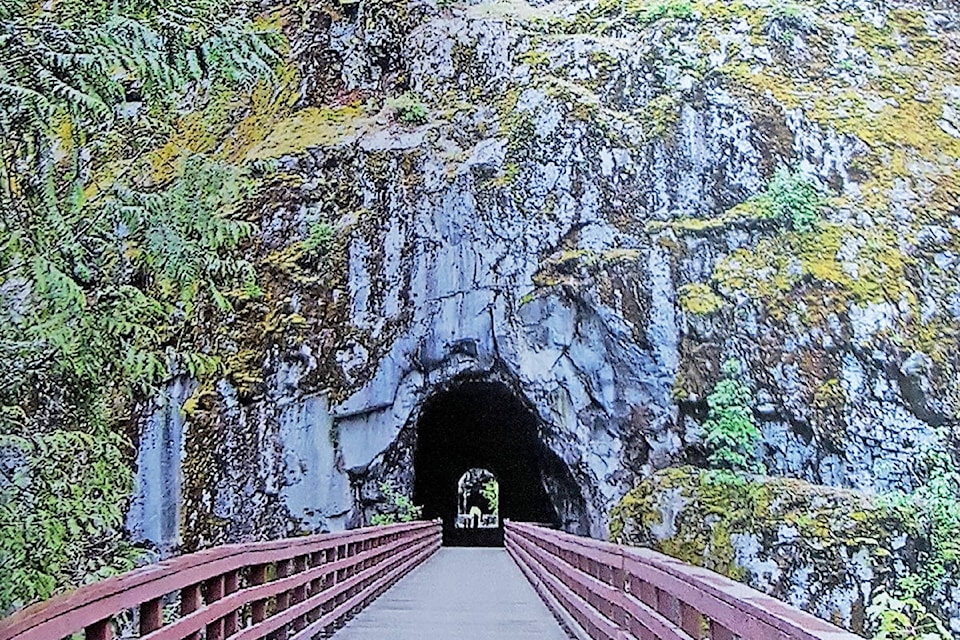Barry Sale
Special to the Tribune/Advisor
Normally when I travel down to the coast I take the Fraser Canyon route.
However, this past summer, I decided to do the Coquihalla highway (better to do it in the summer, rather than in the winter).
I enjoyed the trip and the scenery, but just before descending into Hope, I came across some interesting place names.
There was the Juliette Bridge, Romeo Road, Shylock Road, Portia Creek, and the Othello Tunnels.
Now, I am not an English major, but I know enough to recognize that these are all Shakespearian characters. How did they come to be place names on a busy highway in the Interior of B.C.?
The answer, it turns out, harkens back to the early 1900s, when the Canadian pacific Railway was constructing the Kettle Valley line to connect B.C.’s southern coast with the Kootenay region. Once silver was discovered in the Southern Interior in the spring of 1887, thousands of American miners flooded into the region.
READ MORE: The interesting history of the Rose Lake Lodge
They quickly determined that it was quicker and cheaper to get their supplies and to ship the ore via the Northern Pacific Railroad that came through Spokane, Washington.
Fearing that this region of B.C. would, in effect, become a commercial annex of the U.S., provincial and federal officials quickly agreed that a second “Coast to Kootenay” railroad within B.C. was essential.
The route chosen hooked up with the CPR main line at Hope, and passed through Princeton, Summerland, Penticton, Beaverdell, and ended in Midway.
An additional earlier constructed branch line connected to Spences Bridge and Merritt.
The construction of the Kettle Valley main line began in 1910, under the direction of C.P. Rail’s Chief Engineer, Andrew McCulloch (1864-1945).
It proved to be the most challenging project of his career. The route cut through three mountain ranges and had to deal with steep grades and deep gorges.
The roughest part by far was the Coquihalla Canyon.
McCulloch decided that a straight section of track through this area was required, and in order to achieve this, five closely aligned tunnels had to be constructed.
In addition, two bridges had to be built between three of the tunnels.
Because there were five tunnels they were originally named the Quintette Tunnels.
With sheer, vertical walls, harsh rain and snow conditions, and questionable safety standards, the construction workers faced some daunting challenges.
READ MORE: The great bean strike
Cliff ladders, suspension bridges, and simple ropes were all used to provide access to almost impossible areas.
Dynamite was used to blow passages through the solid rock. Difficult and dangerous jobs were given to Chinese labourers to do, several of whom were killed by falls or by explosives.
Construction of the Kettle Valley line was completed in 1916.
It was truly an engineering marvel, and the newspapers of the day referred to it as “McCulloch’s Wonder.”
The route was officially opened in April of that year. It turned out that McCulloch was an avid reader of Shakespeare.
April, 1916 was the 300th anniversary of the subdivision stations after characters in Shakespearian plays.
Thus, the first 10 stations after Hope were Othello, Lear, Jessica, Aurum, Shylock, Portia, Iago, Romeo, Coquihalla, and Juliette.
Over the years, roads, lakes, bridges and creeks have taken on these names, and the five tunnels, because they are close to the old Othello Station, have become commonly known as the Othello Tunnels.
Much of the Coquihalla Highway is built upon the original railbed of the Kettle Valley Railway.
Rail service on the KVR consisted of both passenger and freight trains.
The freight included ore from the Kootenays, forestry products and fruit from the Okanagan.
Over its lifespan, the KVR was called upon, on numerous occasions, to act as “second mainline” when washouts, rock slides, or avalanches closed off the main CPR line through the Fraser Canyon.
But the KVR itself was especially prone to weather problems, with many mudslides and snow storms putting it out of commission for days at a time.
Over a two-year period in the mid 1930s the line was only open for a total of two weeks.
A series of washouts in 1959 brought the line to a standstill, and CPR officials in Montreal decided to close the line permanently.
Freight was discontinued in 1961, and the last passenger train completed its run in 1964, although parts of the KVR in the Okanagan continued independently until 1989.
Once the Othello Tunnels and associated trestles were decommissioned, the old rail bed became a popular hiking trail, and in 1986, the area was renamed the Coquihalla Canyon Provincial Park.
The Tunnels now form part of the Trans Canada Trail system.
They are the most important visitor attraction in the Hope area, providing people with a look into history, spectacular views, hiking, biking, photography, picnicking and even fishing.
They are regularly closed each winter during unsafe conditions, and occasionally in the summer, as well if there are too many slides.
They are well worth a visit, but if you can’t get there personally, you can still check them out in two movies, Rambo - First Blood, and Cabin In the Woods.
It’s amazing how some unusual road signs can lead to another piece of B.C.’s history.
Do you have a comment about this story? email:
editor@wltribune.com
Like us on Facebook and follow us on Twitter.
